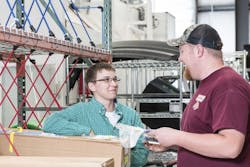As the conversation carried on, Jeff Yokum noticed something strange. Something different. Something that definitely never happened in his own office.
He was listening to another shop owner after seeking advice on properly managing employees in his own shop, Yokum’s Body Shop in Willits, Calif. And unlike the norm at Yokum’s shop at the time, not once did an employee interrupt their conversation with a problem.
It wasn’t that he didn’t employ quality workers. When Yokum took the shop over from his father six years ago, he inherited a hard-working staff that had collectively accumulated years of experience in the industry. But without policies and procedures in place, and with no focus on improving processes and carrying the business forward, things were a bit messy: communication was poor, redos were common, and Yokum was too busy putting out fires to think about the future of the business.
Establishing those policies, stressing nonverbal communication, delegating duties and becoming a more attentive leader has allowed Yokum to gain control over his shop. And these days, when he sits in his office, going over KPIs and brainstorming ways of making the business more profitable, he doesn’t take the silence for granted—it’s something he’s worked years to achieve.
What I’ve learned over the past six years is being an owner these days is different than what my parents were used to. My dad was constantly in the business, on the floor, managing every little thing. The attitude was, “You’ve got to be on the front counter, be the face of the business, be on the front line.”
Yokum’s Body Shop
Location: Willits, Calif.
Size: 9,000 square feet
Staff: 12 (4 technicians, 2 estimators, 1 painter, 1 prepper, 1 detailer, 1 parts manager, 1 CSR, 1 owner)
Average Monthly Car Count: 88
Annual Revenue: $1.73 million
For me, being the owner is more about observing, mentoring, training, making sure everyone is getting their job done the right way. I need to hire the right crew, and then let them handle customers while I work on the owner’s duties. I’m thinking about the future, trying to be an executive rather than just a business owner.
I get here at 8 a.m., go out to the floor and greet everybody. I say good morning and get an idea of what’s going on with the employees in each department.
Everybody here is usually pretty happy, but if anybody looks upset, I’ll confront them and ask what’s going on. Sometimes they’re just grumpy, but other times it ends up being a larger conversation.
It’s all about confronting and getting ahead of those situations and getting a good grasp on how the day is going to go. Maybe they’ve had a major incident in their family life. If so, we can go to my office and talk about it, and I’ll help walk them through it. I think of my staff as my family, and I try to empathize with them about those stressful moments outside of work that could affect everyone else in the shop.
I took a five-day estimator class through Management Success!, for example, and the first three days are intense communication training. There were three days of communication training, and then two days of drills and workshops on how to get your employees to get things done for you.
Between 8 and 10 a.m., I do a walkaroud with the production manager. We get a feel for every vehicle, touch each vehicle with our hands, and take notes for the daily 10 a.m. production meeting.
At the meeting, everyone comes into the office and we discuss the work in progress. We discuss any issues or pressing questions: “Does this customer need to be updated today? Do we need to give them a call? Is there an issue with insurance? Are we waiting on a supplement for this vehicle? Do we need to put a paint list together for these vehicles?”
These conversations have resulted in a lot of changes in processes, which has freed me up to do more executive-level leading. It’s been all about figuring out the stages of a shop, hiring more people and delegating more duties to the front office staff, and moving toward the final stage, where every job description is written up. We have an organizational board that lays out who is in charge of what. It’s all about getting the right people in place to run daily operations so I can concentrate more on the owner duties.
Every idea is about amending our policies and procedures for improving workflow. Stressing nonverbal communication has become key for us, so one day I decided I’d conduct a test where we pretended we had tape on our mouths, which required everyone to communicate without speaking.
That produced a new system: When you dispatch the job, you put it in a bin for the technician who will take that job. When he’s done tearing down the vehicle, he comes down and puts the paperwork in the bin for the estimator so he can do a supplement. And then, when the job is ready for paint, he hangs it on the paint hook over on the paint booth. As the car moves down the line, people check off their duties on our workflow chart.
This led to me creating an audit checklist. When a closed job comes into my office for the final payment, I can pull out my checklist, go down through the whole file and tell if the job, from start to finish, has been handled the way I want it done: Were the documents filled out properly? Was the workflow followed? Did the technicians clock in and out properly? Was the final bill assigned properly? Was the authorization for the repair signed? I can tell if all the policies and procedures in the shop were followed.
I also spend a lot of time poring over our statistics in my office, finding our weak spots. I’ll log into the shop manager program, print out graphs each week and month for production efficiency, billed hours, average estimate, etc.
I manage through those stats. If an employee came in and wanted a raise in the old days, you might be by the seat of your pants: “Oh, well you’ve been here a long time, working hard, we can give you a raise.”
And then I’ll say, “You know, Bill has billed considerably more hours than you. Why don’t we try to get your billed hours up to this amount for a consistent three or four weeks, and then we can talk about that raise.”
For the rest of the afternoon, I’m between my office and observing and mentoring on the floor. We’re tweaking the workflow, policies and procedures all the time to keep everything moving forward.
I’ll confront any issues I see directly and rewrite policies so we can put them in place and follow that in the future. My shop’s efficiency when I started three years ago was way under 100 percent, it was in the 80s. Today our efficiency stands at 158 percent for the whole shop, and that is phenomenal.
Honestly, there isn’t anything I do with the end of my day. I’m usually gone by 4 p.m., before all my guys leave. Then I let the crew lock up.
Actually, now that I’m thinking about it, it’s pretty amazing I’ve gotten to this state. I used to work 12-hour days, and I was always the last one in the shop. Now I’ve got a team that doesn’t always need me here to get things done. They’re professionals and know what I expect of them. We’re all in sync and the workflow improves every day.

